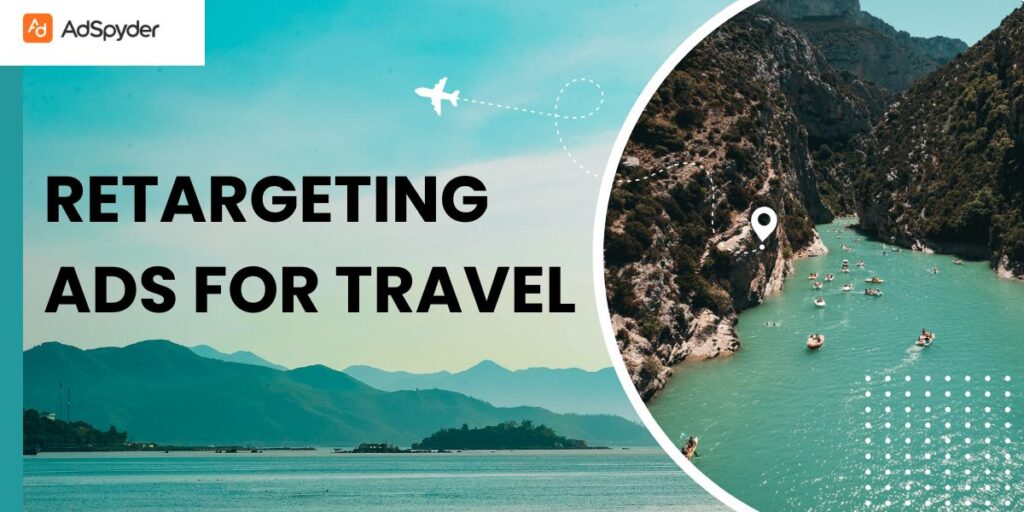The travel industry needs to make acquisition efforts a top priority because market competition maintains its strength. Multiple sites and different choice sets from tourism operators make up the extensive research process that travellers follow before finalising their booking. People interact extensively before buying and experience both difficulties and potential benefits during this process. Users show interest in your travel service options, but usually make their booking reservations later. Retargeting ads for travel create an influential impact on the target audience by re-engaging potential customers at the right time.
Ready to Elevate your Marketing Strategy?
Your travel advertising campaigns display your services in front of undecided customers’ minds to keep them driven toward booking decisions. This complete travel booking retargeted advertisement guide contains proven advertising methods that help boost your sales performance.
What is Retargeting?
This marketing method known as retargeting or remarketing presents adverts to individuals who have engaged with your website applications and digital material in the past. Your travel booking advertisement strategy targets users who have accessed your platform for bookings and also targeted those who performed destination searches and package viewings and left their booking process incomplete. Your targeted advertisements recollect your services to past visitors while showcasing marketplace value so they reconsider booking with your company.
Why is Retargeting Crucial for Travel Bookings?
Travel depends fully on people’s spontaneous choices and inspirational decisions. Retargeting generates essential advantages through its capability of leveraging these factors.
- Recapturing Lost Leads: Several booking procedures end midway because customers get disrupted, check other options for prices, or need additional time to choose before completing their booking. Through retargeting marketing, it becomes possible to establish another connection with consumers who previously viewed your services.
- Increased Brand Recall: The repetition of your ads to individuals who encountered your brand formerly enhances brand recognition while building stronger brand awareness. Your brand visibility improves when these clients think of booking services.
- Personalised Messaging: Retargeting lets you display customised ads through your marketing platform because a user has already engaged with your website. For example, you can show ads for the exact vacation package a user viewed or offer a discount on a flight they previously searched for.
- Improved Conversion Rates: When you retarget interested travel customers they become more likely to make purchases rather than traditional audience marketing tactics.
- Cost-Effectiveness: When you direct advertising efforts towards users who know your brand, you get better campaign results at a lower cost.
- Cross-Device Reach: The retargeting strategy lets your ads appear to users on every device they use, including computers, tablets, and mobile phones. Retargeting can reach users across multiple devices, ensuring your ads are seen whether they are browsing on their desktop, tablet, or smartphone.
- Enhanced Customer Engagement: Retargeting advertisements send targeted content like destination books or travel tactics to enhance customer connections and strengthen brand support.
Related – Local Tourism Advertising
How Retargeting Works for Travel Niche

The retargeting process includes these main actions:
- Website Tagging: Your website receives a single small code block known as a pixel. Our pixel system detects what users do on our site by registering their activity when they view pages, use search options and put things in their shopping cart.
- Audience Creation: Based on the data collected by the pixel, you create audience segments of users who have performed specific actions on your website. You build advertisements that match the needs of each group you try to reach. Your digital advertisements may take form as written text, visual pictures or moving video.
- Ad Creation: Targeted advertisements in various platforms appear for your chosen audience under the Google Display Network and social media sites.
- Ad Delivery: Your retargeting ads are then displayed to the targeted audience across various platforms, such as Google Display Network, social media platforms, and other websites.
- Conversion Tracking: By monitoring how well your retargeted content performs, you can determine if it helps users complete their purchase steps.
Key Retargeting Platforms for Travel Bookings
A large number of retargeting solutions help travel companies scale their advertising efforts.
- Google Ads: Google Display Network connects your ads to millions of websites and apps through Google Ads. You can draw users back through RLSA tools when they use Google to search while prior website visitors remain on the list.
- Social Media Platforms (Facebook, Instagram, Twitter, etc.): Social media platforms offer powerful retargeting options, allowing you to reach users based on their interests, demographics, and website behaviour. These sites deliver outstanding results for attractive advertising materials aimed at travel markets.
- Travel-Specific Ad Networks: Travel advertising networks develop retargeting solutions that serve the needs of the tourism industry.
Strategies for Effective Travel Retargeting
A good retargeting approach needs detailed preparation and proper management to succeed. Follow these main strategies to develop your campaigns.
Segment Your Audience
Do not use the same web marketing strategy for all your website viewers. Reshape your marketing groups by separating visitors who looked at particular destinations from people who wanted to buy items without finishing their purchase, and people who downloaded tour materials. Your retargeting strategy works better when you create different advertising messages for each targeted audience segment.
Personalise Your Ads
Making ads personal helps you get the attention of customers you want to reach. Exhibit travel advertisements that match what each user wants to explore. Present ads that show the specific hotel or nearby hotels in Paris when users view them through our platform. Dynamic retargeting campaigns work very well when they display exact product details for the audience to see.
Offer Incentives
Use discount offers and bonus facilities to make users complete their booking transactions. Free items must include an expiration time to generate a sense of urgency from potential customers.
Create Compelling Ad Creatives
Keep your retargeting advertisements both attractive and captivating for viewers. Show your targeted audience beautiful, diverting pictures and video shots of your travel destinations. The text of your ads should be easy to follow while persuading users through content that matches their pursuit of travel experiences.
Frequency Capping
Avoid bombarding users with too many retargeting ads. Set frequency caps to limit the number of times a user sees your ads within a given timeframe. Establish an automatic system that controls how many times your ads show to each user during their chosen time period. Constant exposure to our ads would make them undesirable and create a negative experience for viewers.
Timing and Placement
Monitor when your target audience logs in and select ideal promotional spots. You can display ads to individuals who stopped booking their trips within 24 hours, and also show them to people who visit travel sites and social media.
Cross-Device Targeting
Design your retargeting strategy to show ads on various devices that users use. Most people look up travel info on their desktop before using their mobile phone to finalise purchases. The method lets you reach users on any platform they prefer to access the internet. Many travellers research on their desktop but book on their mobile device. Cross-device targeting allows you to connect with these users regardless of the device they are using.
A/B Testing
Test different ad designs and text versions while making specific audience choices through our experiment method. You can make your retargeting methods more valuable through A/B testing.
Landing Page Optimisation
Ensure your landing pages are relevant to your retargeting ads and provide a seamless booking experience. Make sure your retargeting ads direct users to landing pages that match the information they see in ads and easily guide them to book their stay. Design landing pages that work well on mobile devices while staying simple to use and built for buyers to take action easily.
Monitor and Analyse
Keep track of your retargeting activities to view their results and make sure they deliver their intended goals. Use your data results to learn which aspects of your plans succeed and which do not, then modify your plans accordingly.
Advanced Retargeting Techniques for Retargeting Ads for Travel

These are few of the advanced retargeting techniques that help turn browsers into bookers:
- Customer Match: Use your current client email database to run ads that show chosen offers or promotions to existing customers.
- Lookalike Audiences: Build target groups of potential customers from your existing clientele by matching their traits.
- Website Custom Audiences: You can build audience segments from website behaviour, including page visits, shopping cart updates and downloaded brochure cases. Create custom audiences based on specific actions users have taken on your website, such as visiting specific pages, adding items to their cart, or downloading a brochure.
- Engagement Retargeting: Rephrase your social media targeting to reach users who took engagement actions like liking or sharing your posts.
Measuring Success and ROI in Retargeting Ads for Travel
You need to evaluate your retargeting campaigns to see whether they produce good results and use the data to plan future advertising.
- Key Performance Indicators (KPIs): Set the key performance indicators that help you track your marketing target achievement. Standard performance indicators for travel retargeting campaigns consist of these metrics:
- Click-Through Rate (CTR): Visitors clicked on our ads during impressions to reach this metric.
- Conversion Rate: A booking occurred for every x clicks in our advertisements.
- Cost Per Acquisition (CPA): Bookings cost you an average amount of money for each purchase.
- Return on Ad Spend (ROAS): Our advertising expenses generate this specific income amount.
- View-Through Conversions: Users who take action once they see your advertisement without clicking on it produce View-Through Conversions. The metric displays brand impact by showing how often people see and become aware of your campaigns.
- Attribution Modelling: Our system tracks how each contact point in the customer journey leads to a booking. Attribution modelling shows you which advertising channels deliver the best results when it comes to booking achievement.
- A/B Testing Results: Check which test versions performed best to find the strongest advertisement designs and marketing methods. Analyse the results of your A/B tests to identify the most effective ad creatives, messaging, and targeting options.
- Regular Reporting and Analysis: Create normal reports to track your moves and find noticeable patterns. Look at your data to find out which methods succeed and which fail, then modify your approach.
Best Practices for Retargeting Ads for Travel

These are some of the best practices for Travel Retargeting Ads:
- Focus on Value: Position your advertising message to show how your travel services deliver better benefits to customers during your retargeting campaign. Highlight the value proposition of your travel services in your retargeting ads. What makes your offerings unique and appealing to travellers?
- Create a Sense of Urgency: Ads that mention limited periods of availability and time limits should convey urgency.
- Use High-Quality Visuals: Show your travel destinations to potential visitors by using crisp professional media content. Use professional, high-resolution images and videos that showcase the beauty and excitement of your travel destinations.
- Keep Your Ads Fresh: Change your ad designs on a regular basis because ads that stay static will lose audience interest. Rotate your ad creatives regularly to avoid ad fatigue and keep your ads engaging.
- Match the Ad to the Landing Page: The landing pages need to represent the ads with content that matches what potential visitors want to see and book.
- Mobile Optimisation: Make it easy for device users to view your promotions and access your landing pages on their mobile phones.
- Test and Iterate: Regularly test your ads through multiple variations to improve their ability to produce successful results.
Common Mistakes to Avoid in Retargeting Ads for Travel
These are the most commonly occurring mistakes that can be best avoided:
- Not Segmenting Your Audience: You cannot create targeted retargeting efforts when you treat every website guest in the same way. Treating all website visitors the same will result in less effective retargeting campaigns.
- Showing Irrelevant Ads: Showing ads that are not relevant to the user’s travel interests will result in wasted ad spend and annoyed potential customers.
- Ignoring Frequency Capping: Overloading users with excessive advertisements makes them ignore your brand and feel annoyed.
- Not Tracking Performance: You cannot fix what you do not measure. This is because your inability to monitor retargeting success stops you from finding ways to make it better. Failing to track the performance of your retargeting campaigns will prevent you from identifying areas for improvement.
- Neglecting Landing Page Optimisation: Sending users to inappropriate landing pages that look bad will reduce your campaign conversion numbers.
The Future of Retargeting in Travel
Retargeting stays modern due to progress in technology as users alter their buying habits. Several important aspects to track include:
- Increased Personalisation: Streaming ads will make stronger connections through targeted information based on thorough user data. Retargeting ads will become even more personalised, leveraging data to deliver highly relevant and engaging experiences.
- AI and Machine Learning: AI technology will control more retargeting actions by running automated tasks to enhance campaign quality. AI and machine learning will play a greater role in optimising retargeting campaigns, automating tasks and improving performance.
- Cross-Channel Retargeting: The business practice of retargeting will move from its familiar bases in display and social networks to all marketing channels, especially email and video.
- Focus on User Experience: Retargeting ads will use user experience as a guide to show relevant messages that do not disrupt the journey and improve what users get from these products.
Conclusion
Travel companies use retargeting to bring back potential customers and enhance brand visibility while producing better results. By following these strategies, you can build retargeting efforts that boost sales performance and reach marketing targets. Effective retargeting needs both time and regular improvements to reach success. Continuous updates on industry trends and strategy improvements will help you earn more from your travel business during market competition. Stay up-to-date with the latest trends and continuously refine your strategies. You can maximise your return on investment and thrive in the competitive travel industry.
FAQs for Retargeting Ads for Travel
What is retargeting in the context of travel bookings?
Your past website users receive targeted ads from your travel business. This is to keep them interested and motivate them to make a booking. Retargeting shows ads to users who have previously interacted with your travel website or app. It reminds them of your offerings and encourages them to complete a booking.
Why is retargeting important for travel businesses?
It helps us reacquire forgotten prospects, helps people remember our brand better while receiving customised promotions, strengthens sales and saves us money.
How does retargeting work?
Your website pixel monitors user activities and groups related users into segments before serving them targeted ads across multiple platforms. A pixel on your website tracks user behaviour. It creates audience segments, and then displays targeted ads to those segments across various platforms.
Which platforms are best for travel retargeting?
Google Ads, social media platforms (Facebook, Instagram, etc.), and travel-specific ad networks are all effective options.
What are some key strategies for successful travel retargeting?
Identify your audience groups and make personalised ads with deals while developing engaging ad materials and keeping total ad views limited on relevant landing pages.
How do I measure the success of my retargeting campaigns?
Track KPIs like CTR, conversion rate, CPA, ROAS, and view-through conversions. Use attribution modelling and analyse A/B testing results.
What are some common mistakes to avoid when retargeting travel?
Marketers make these major mistakes when they fail to properly group their viewers, display incorrect promotions, fail to set display limits, and ignore results, plus weaken their landing page.




